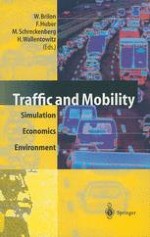1999 | OriginalPaper | Buchkapitel
The Development of a Unified Modeling Framework for the Household Activity-Travel Scheduling Process
verfasst von : S. T. Doherty, K. W. Axhausen
Erschienen in: Traffic and Mobility
Verlag: Springer Berlin Heidelberg
Enthalten in: Professional Book Archive
Aktivieren Sie unsere intelligente Suche, um passende Fachinhalte oder Patente zu finden.
Wählen Sie Textabschnitte aus um mit Künstlicher Intelligenz passenden Patente zu finden. powered by
Markieren Sie Textabschnitte, um KI-gestützt weitere passende Inhalte zu finden. powered by
The goal of this paper is to propose a new approach to activity-travel schedule modeling that provides a unifying framework for past research in different areas. This approach is based on empirical evidence gathered using a Computerized Household Activity SchEduling (CHASE) survey. The survey provided a means to examine the underlying scheduling behavior of household over a one week period as it occurs in reality. Results show that a clear distinction can be made between routine scheduling decisions that are pre-planned before the week commences, and the more short-term, impulsive, opportunistic decisions made as the schedule is executed during the week. This distinction allows one to conceptualize the modeling task as a multi-stage process, wherein routine planning is approached with existing optimization models (assuming that routine activities are the result of a long-term thought and experimentation process) followed by a more sub-optimal rule-based simulation model to replicate the decisions process during the week within the constructs of the optimal routine plan. Such a model is proposed in this paper as a long term development, and would rely on the type of data provided by new data collection techniques such as CHASE. Operationalization of the model as an event-oriented simulation is proposed. Various components of the model are explored in detail, and discussed within context of existing models.
